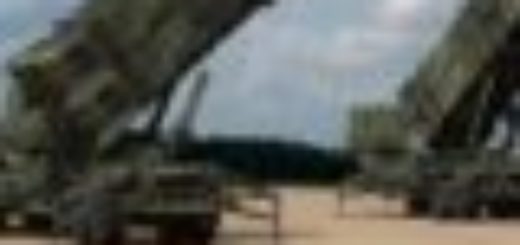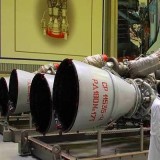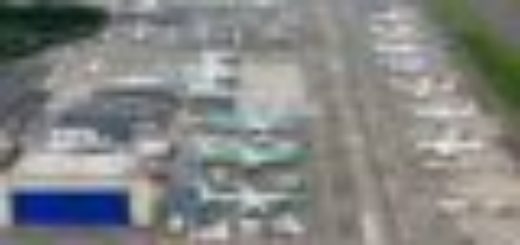L3Harris Expands Space Payload Production to Support US Golden Dome Missile Defense Initiative

{loadposition bannertop}
{loadposition sidebarpub}
On April 16, 2025, L3Harris Technologies announced the completion of a major expansion at its space payload production facility in Fort Wayne, Indiana. Valued at $125 million, this strategic investment is intended to support the development of the United States’ space-based missile defense program, known as “Golden Dome for America.” The initiative aims to establish an advanced technological shield around U.S. territory capable of detecting and intercepting ballistic and hypersonic threats. The facility’s expansion aligns with the U.S. Department of Defense’s current efforts to strengthen orbital surveillance and defense capabilities and supports the broader national security priorities defined during President Trump’s second term.
Follow Army Recognition on Google News at this link
The facility’s expansion now enables L3Harris to achieve an annual production capacity of 48 payloads, in line with the rising needs of U.S. military programs (Picture source: Army Recognition Edit)
The dedication ceremony for the new 95,000-square-foot building brought together members of Indiana’s congressional delegation. Representative Marlin Stutzman (R-IN) described the initiative as a return to a “Made in America” defense industry. He highlighted the expected economic benefits, emphasizing that the new jobs would inject millions of dollars into the local economy and could serve as a model for other companies seeking to reshore their industrial operations. He also noted the importance of industrial communities in sustaining national defense capabilities.
The facility’s expansion now enables L3Harris to achieve an annual production capacity of 48 payloads, in line with the rising needs of U.S. military programs. Ed Zoiss, President of Space and Airborne Systems, indicated that the company is now equipped to deliver at a pace that matches Pentagon requirements while supporting protection against emerging threats. This increased capacity directly supports key programs such as the Space Development Agency’s Tracking Layer and the Missile Defense Agency’s Hypersonic and Ballistic Tracking Space Sensor (HBTSS), for which L3Harris is currently developing 34 satellites in addition to the five already in orbit.
Initially specialized in infrared sensors for civil weather satellites, notably for NOAA’s GeoXO program, the Fort Wayne site has leveraged its technical expertise to enter the space defense sector. Infrared sensors capable of providing real-time data are essential for early warning and detection of missile threats. L3Harris aims to transition from one-off space missions to scalable production of high-value payloads. Rob Mitrevski, Vice President and General Manager of Spectral Solutions, explained that this industrial transformation focuses on improving predictability, production rates, and delivery timelines—crucial in a context where rapid response is increasingly important.
This strategic shift has allowed L3Harris to position itself as a key player in an area where it had limited presence until recently. The company now reports a $2.5 billion order backlog for missile defense work alone. According to Mitrevski, this success stems from a careful assessment of strategic developments among potential adversaries, who have significantly advanced their own missile capabilities. The U.S. response, embodied in the Golden Dome concept, was therefore seen as inevitable.
The “Golden Dome for America” initiative, launched by the Trump administration, seeks to deploy a comprehensive missile defense shield based on a modular architecture of integrated defense layers. Unlike a monolithic system, the Golden Dome will be composed of a “system of systems,” including orbital sensor constellations such as HBTSS and Tracking Layer satellites. These will detect launches using continuous infrared surveillance and be connected to command-and-control networks such as the C2BMC (Command and Control, Battle Management, and Communications) system already used in the current U.S. missile defense architecture.
To neutralize threats, the system will rely on a combination of terrestrial, naval, airborne, and potentially space-based interceptors. These include THAAD (Terminal High Altitude Area Defense) missiles, PAC-3 MSE, the NGI (Next Generation Interceptor) for exo-atmospheric defense, and sea-based Aegis systems equipped with SPY-1 radars. The Long Range Discrimination Radar (LRDR) will provide long-range target discrimination. In the longer term, the architecture may also incorporate space-based interceptors and artificial intelligence for data fusion and real-time decision support. Platforms like the F-35 could function as tactical command nodes within a multi-domain, interconnected framework.
To neutralize threats, the Golden Dome for America system will rely on a combination of terrestrial, naval, airborne, and potentially space-based interceptors (Picture source: US DoD )
The development of the Golden Dome marks a departure from traditional Pentagon procurement processes, often considered too slow in the face of evolving threats. General Chance Saltzman, Chief of Space Operations for the U.S. Space Force, clarified that there would be no single contract award for the initiative. Instead, the program will be built from multiple coordinated efforts across government agencies and industry partners. Requests for information have already been issued to the private sector to identify viable solutions. The goal is to establish an initial operational capability within two to four years by combining proven systems with emerging technologies, rather than waiting for a final and perfected design.
The scope of the investment at Fort Wayne extends beyond defense applications. The site will also support increased satellite production for civil weather programs serving international clients. L3Harris aims to remain a major provider of critical space technologies across both military and civilian domains. This expansion comes amid recent U.S. tariff increases, including specific measures targeting China. Mitrevski stated that while the long-term impact of these tariffs is still uncertain, the company’s largely domestic supply chain could help buffer potential disruptions in raw material sourcing.
In this context of strategic industrial realignment, Lockheed Martin has also confirmed its readiness to support the Golden Dome initiative, offering its most advanced technologies to help build an integrated air and missile defense system covering the entirety of U.S. territory. Lockheed’s announcement underscores the growing mobilization of the American defense industry around this large-scale national project.
Ultimately, the expansion of the Fort Wayne site reflects L3Harris’ intent to integrate itself fully into the emerging U.S. space defense architecture. Through increased production capacity, proactive anticipation of defense requirements, and reshoring of key manufacturing capabilities, the company strengthens its position within the broader U.S. defense space ecosystem. The Golden Dome program—now supported by multiple major contractors and based on both proven and developing technologies—emerges as a scalable, coordinated response to the evolving landscape of global missile threats.

{loadposition bannertop}
{loadposition sidebarpub}
On April 16, 2025, L3Harris Technologies announced the completion of a major expansion at its space payload production facility in Fort Wayne, Indiana. Valued at $125 million, this strategic investment is intended to support the development of the United States’ space-based missile defense program, known as “Golden Dome for America.” The initiative aims to establish an advanced technological shield around U.S. territory capable of detecting and intercepting ballistic and hypersonic threats. The facility’s expansion aligns with the U.S. Department of Defense’s current efforts to strengthen orbital surveillance and defense capabilities and supports the broader national security priorities defined during President Trump’s second term.
The facility’s expansion now enables L3Harris to achieve an annual production capacity of 48 payloads, in line with the rising needs of U.S. military programs (Picture source: Army Recognition Edit)
The dedication ceremony for the new 95,000-square-foot building brought together members of Indiana’s congressional delegation. Representative Marlin Stutzman (R-IN) described the initiative as a return to a “Made in America” defense industry. He highlighted the expected economic benefits, emphasizing that the new jobs would inject millions of dollars into the local economy and could serve as a model for other companies seeking to reshore their industrial operations. He also noted the importance of industrial communities in sustaining national defense capabilities.
The facility’s expansion now enables L3Harris to achieve an annual production capacity of 48 payloads, in line with the rising needs of U.S. military programs. Ed Zoiss, President of Space and Airborne Systems, indicated that the company is now equipped to deliver at a pace that matches Pentagon requirements while supporting protection against emerging threats. This increased capacity directly supports key programs such as the Space Development Agency’s Tracking Layer and the Missile Defense Agency’s Hypersonic and Ballistic Tracking Space Sensor (HBTSS), for which L3Harris is currently developing 34 satellites in addition to the five already in orbit.
Initially specialized in infrared sensors for civil weather satellites, notably for NOAA’s GeoXO program, the Fort Wayne site has leveraged its technical expertise to enter the space defense sector. Infrared sensors capable of providing real-time data are essential for early warning and detection of missile threats. L3Harris aims to transition from one-off space missions to scalable production of high-value payloads. Rob Mitrevski, Vice President and General Manager of Spectral Solutions, explained that this industrial transformation focuses on improving predictability, production rates, and delivery timelines—crucial in a context where rapid response is increasingly important.
This strategic shift has allowed L3Harris to position itself as a key player in an area where it had limited presence until recently. The company now reports a $2.5 billion order backlog for missile defense work alone. According to Mitrevski, this success stems from a careful assessment of strategic developments among potential adversaries, who have significantly advanced their own missile capabilities. The U.S. response, embodied in the Golden Dome concept, was therefore seen as inevitable.
The “Golden Dome for America” initiative, launched by the Trump administration, seeks to deploy a comprehensive missile defense shield based on a modular architecture of integrated defense layers. Unlike a monolithic system, the Golden Dome will be composed of a “system of systems,” including orbital sensor constellations such as HBTSS and Tracking Layer satellites. These will detect launches using continuous infrared surveillance and be connected to command-and-control networks such as the C2BMC (Command and Control, Battle Management, and Communications) system already used in the current U.S. missile defense architecture.
To neutralize threats, the system will rely on a combination of terrestrial, naval, airborne, and potentially space-based interceptors. These include THAAD (Terminal High Altitude Area Defense) missiles, PAC-3 MSE, the NGI (Next Generation Interceptor) for exo-atmospheric defense, and sea-based Aegis systems equipped with SPY-1 radars. The Long Range Discrimination Radar (LRDR) will provide long-range target discrimination. In the longer term, the architecture may also incorporate space-based interceptors and artificial intelligence for data fusion and real-time decision support. Platforms like the F-35 could function as tactical command nodes within a multi-domain, interconnected framework.

To neutralize threats, the Golden Dome for America system will rely on a combination of terrestrial, naval, airborne, and potentially space-based interceptors (Picture source: US DoD )
The development of the Golden Dome marks a departure from traditional Pentagon procurement processes, often considered too slow in the face of evolving threats. General Chance Saltzman, Chief of Space Operations for the U.S. Space Force, clarified that there would be no single contract award for the initiative. Instead, the program will be built from multiple coordinated efforts across government agencies and industry partners. Requests for information have already been issued to the private sector to identify viable solutions. The goal is to establish an initial operational capability within two to four years by combining proven systems with emerging technologies, rather than waiting for a final and perfected design.
The scope of the investment at Fort Wayne extends beyond defense applications. The site will also support increased satellite production for civil weather programs serving international clients. L3Harris aims to remain a major provider of critical space technologies across both military and civilian domains. This expansion comes amid recent U.S. tariff increases, including specific measures targeting China. Mitrevski stated that while the long-term impact of these tariffs is still uncertain, the company’s largely domestic supply chain could help buffer potential disruptions in raw material sourcing.
In this context of strategic industrial realignment, Lockheed Martin has also confirmed its readiness to support the Golden Dome initiative, offering its most advanced technologies to help build an integrated air and missile defense system covering the entirety of U.S. territory. Lockheed’s announcement underscores the growing mobilization of the American defense industry around this large-scale national project.
Ultimately, the expansion of the Fort Wayne site reflects L3Harris’ intent to integrate itself fully into the emerging U.S. space defense architecture. Through increased production capacity, proactive anticipation of defense requirements, and reshoring of key manufacturing capabilities, the company strengthens its position within the broader U.S. defense space ecosystem. The Golden Dome program—now supported by multiple major contractors and based on both proven and developing technologies—emerges as a scalable, coordinated response to the evolving landscape of global missile threats.







